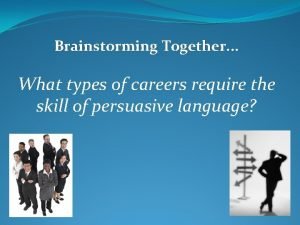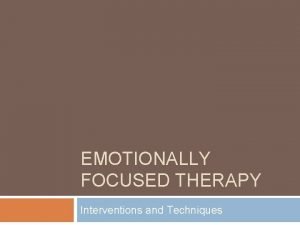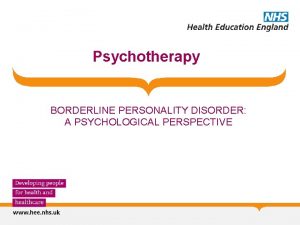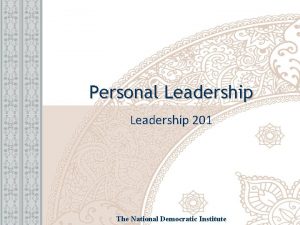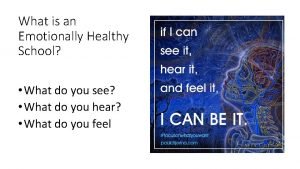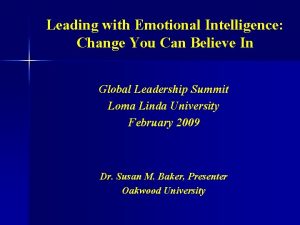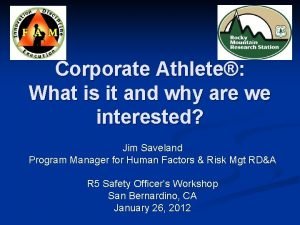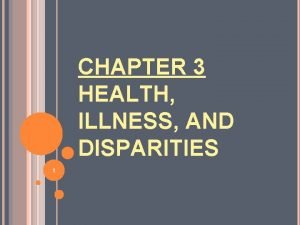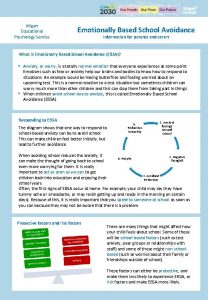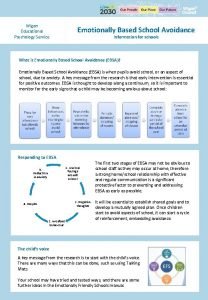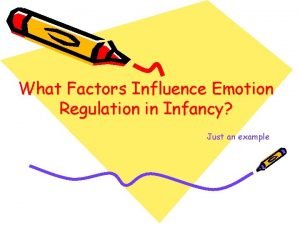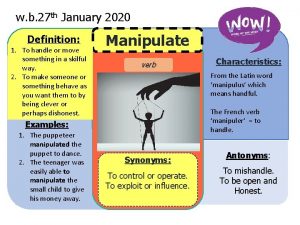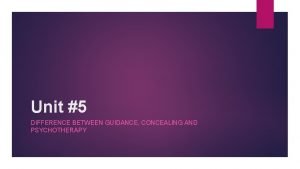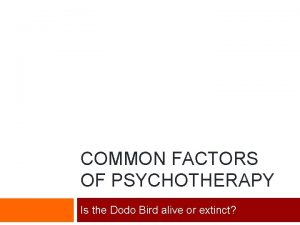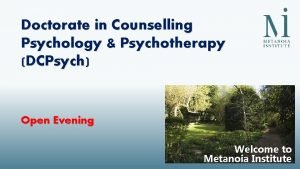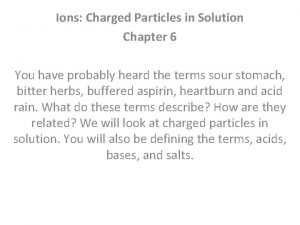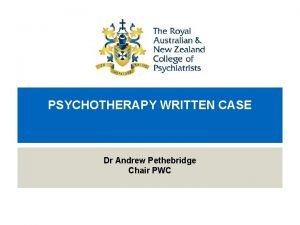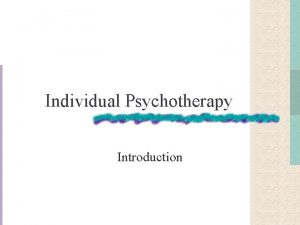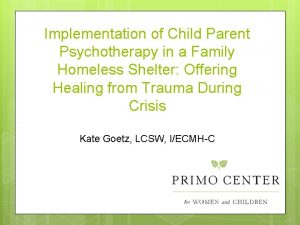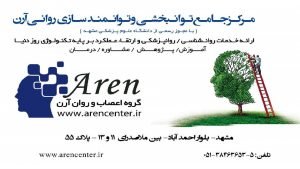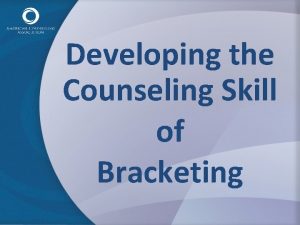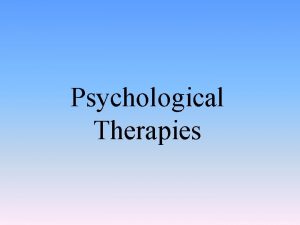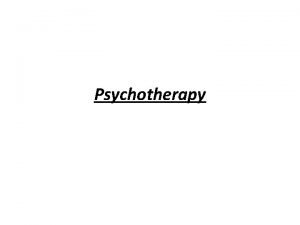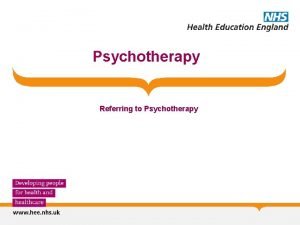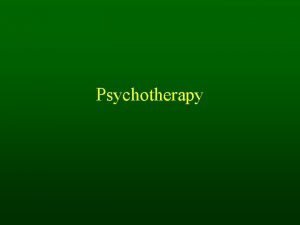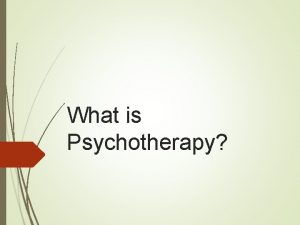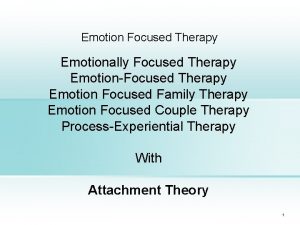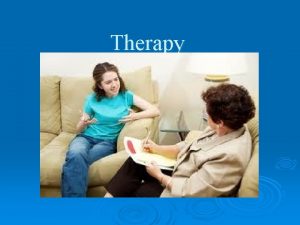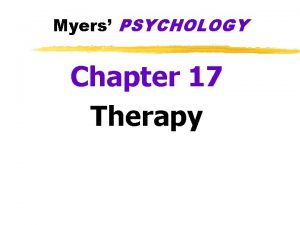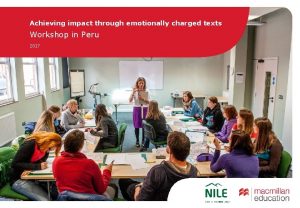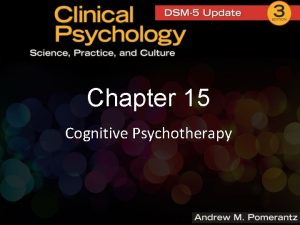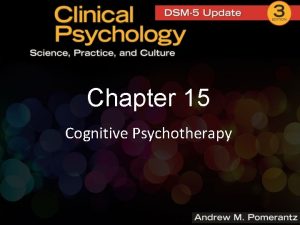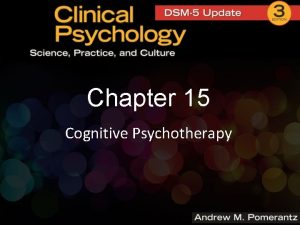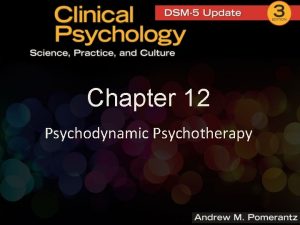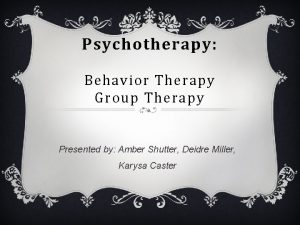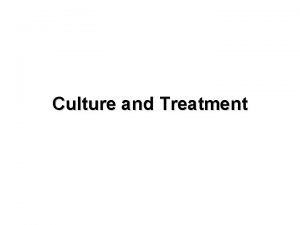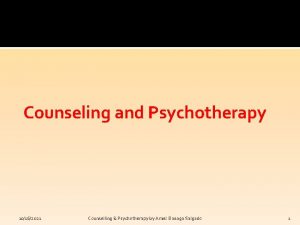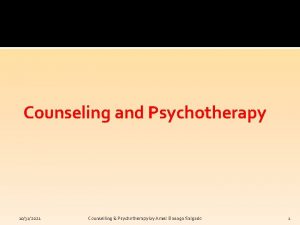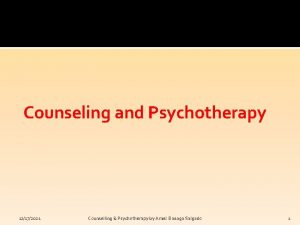Therapy Chapter 17 1 Psychotherapy And emotionally charged



























- Slides: 27

Therapy Chapter 17 1

Psychotherapy • And emotionally charged, and fighting interaction between a trained therapist and someone who suffers from psychological difficulties. Chapter 17 2

Biomedical therapy • Prescribe medication or medical procedures that are directly on the patient’s nervous system. Chapter 17 3

Eclectic approach • An approach to psychotherapy that, depending on the client problems, uses techniques from various forms of therapy. Chapter 17 4

Psychoanalysis • • • Sigmund Freud Free association Resistances Dreams Transference’s An interpretation by a trained professional helping a patient release their regressed feelings. Chapter 17 5

Resistance In psychoanalysis, the blocking from consciousness of anxiety laden material. Chapter 17 6

Interpretation • In psychoanalysis, the analyst’s noting the supposed dream meanings, resistances, and other significant behaviors and events in order to promote in sight. Chapter 17 7

Transference • In psychoanalysis, the patients transferred to the analyst of emotions linked with other relationships. Chapter 17 8

Face-to-face therapy • Missed a therapy session, the catch is disappeared. But the influence of psychoanalysis may not have, especially if therapist probes for the origin of the patient’s symptoms by seeking information from the patient’s childhood. Chapter 17 9

Client centered therapy • A humanistic therapy, developed by Carl Rogers, in which therapist uses techniques such as active listening within a genuine, accepting, empathetic environment to facilitate clients growth. • Also called person centered therapy. Chapter 17 10

Active listening • Empathetic listening in which the listener echoes, restates, and clarifies. Chapter 17 11

Behavior therapy • Therapy that applies learning principles to the elimination of unwanted behaviors. Chapter 17 12

Counterconditioning • A behavior therapy procedure that conditions new responses to stimuli that triggers unwanted behavior; based on classical conditioning. • This can include exposure therapy and aversive conditioning. Chapter 17 13

Exposure therapies • Behavioral techniques, such as systematic desensitization, that treats (in imagination or actuality) to the things they fear and avoid. Chapter 17 14

Systematic desensitization • A type of counter conditioning that associates a pleasant relaxed state with gradually increasing anxiety triggering stimuli. Commonly used to treat phobias Chapter 17 15

Virtual reality exposure therapy • And the anxiety treatment that progressively exposes people to stimulations of their greatest fears, such as airplane flying, spiders, or public speaking. Chapter 17 16

Aversive conditioning • A type of counter conditioning that associates and unpleasant state (such as nausea) with an unwanted behavior (such as drinking alcohol). Chapter 17 17

Token economy • And operant conditioning procedure which people earn a token of some sort for exhibiting a desired behavior and can later exchange the tokens for various privileges or treats. Chapter 17 18

Cognitive therapy • Therapy that teaches people new, more adaptive ways of thinking and acting; based on the assumption that thoughts intervene between events and their emotional reactions. Chapter 17 19

Cognitive behavior therapy • A popular integrated therapy that combines cognitive therapy (changing self-defeating thinking) with behavior therapy (changing behavior). Chapter 17 20

Family therapy • Therapy that treats the family as a system. • Views an individual’s unwanted behavior as an influence by or directed at other family members; attempts to guide family members toward positive relationships and improve communication. Chapter 17 21

Meta-analysis • A procedure for statistically combining the results of many different research studies. Chapter 17 22

Tardive Dyskinesia • involuntary movements of the facial muscles, tong, and limbs; a possible nerve toxic side effects of long-term use of antipsychotic drugs that target D 2 dopamine receptors. Chapter 17 23

Electroconvulsive therapy ECT • A biomedical therapy for severely depressed patients in which a brief electric current is sent to the brain of an anesthetized patient Chapter 17 24

Repetitive transcranial magnetic stimulation • The application of repeated polls as of magnetic energy to the brain; used to stimulate or suppress brain activity. Chapter 17 25

psychosurgery • Surgery that removes or destroys brain tissue in an effort to change behavior. Chapter 17 26

Lobotomy • A now rare psycho surgical procedure once used to, uncontrollably emotional violent patients. The procedure cut the nerves that connected the final lobes of the emotion controlling centers of the brain. Chapter 17 27
 Bandwagon definition propaganda
Bandwagon definition propaganda Emotionally charged words
Emotionally charged words Eft cycle
Eft cycle Emotionally unstable personality disorder
Emotionally unstable personality disorder Personal leadership statement
Personal leadership statement Edprt
Edprt Emotionally healthy schools
Emotionally healthy schools Emotionally unintelligent
Emotionally unintelligent The problem of emotionally unhealthy spirituality
The problem of emotionally unhealthy spirituality Mentally spiritually physically emotionally
Mentally spiritually physically emotionally Mentally spiritually physically emotionally
Mentally spiritually physically emotionally Wigan educational psychology service
Wigan educational psychology service Emotionally based school avoidance
Emotionally based school avoidance Emotionally regulated
Emotionally regulated What is manipulative behavior
What is manipulative behavior Psychoanalytic vs humanistic
Psychoanalytic vs humanistic Bioness integrated therapy system occupational therapy
Bioness integrated therapy system occupational therapy Psychoanalytic therapy is to as humanistic therapy is to
Psychoanalytic therapy is to as humanistic therapy is to Difference between counselling guidance and psychotherapy
Difference between counselling guidance and psychotherapy Dodo effect psychotherapy
Dodo effect psychotherapy Doctorate in counselling psychology
Doctorate in counselling psychology Chapter 6 ions charged particles in solution
Chapter 6 ions charged particles in solution Andrew pethebridge
Andrew pethebridge Psychotherapy ap psychology definition
Psychotherapy ap psychology definition Re-educative individual psychotherapy
Re-educative individual psychotherapy Cpp triangle of explanation
Cpp triangle of explanation Introduction to psychotherapy ppt
Introduction to psychotherapy ppt Kaplan aca
Kaplan aca

